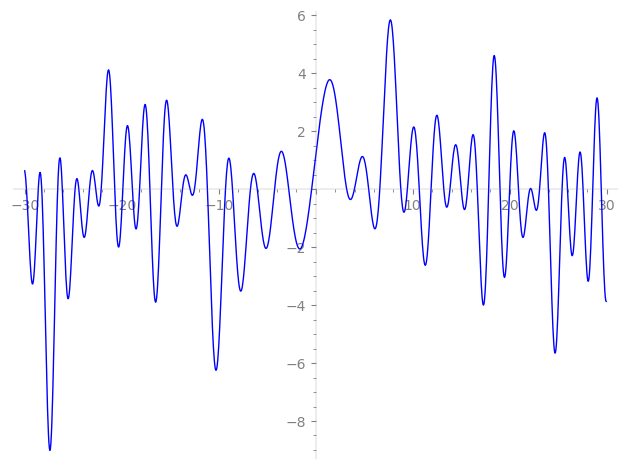| L(s) = 1 | + 3.29·2-s + (1.45 − 8.88i)3-s − 5.16·4-s − 6.84i·5-s + (4.77 − 29.2i)6-s − 58.5·7-s − 69.6·8-s + (−76.7 − 25.7i)9-s − 22.5i·10-s + 62.4·11-s + (−7.49 + 45.8i)12-s + 135.·13-s − 192.·14-s + (−60.7 − 9.93i)15-s − 146.·16-s − 362.·17-s + ⋯ |
| L(s) = 1 | + 0.822·2-s + (0.161 − 0.986i)3-s − 0.322·4-s − 0.273i·5-s + (0.132 − 0.812i)6-s − 1.19·7-s − 1.08·8-s + (−0.947 − 0.318i)9-s − 0.225i·10-s + 0.516·11-s + (−0.0520 + 0.318i)12-s + 0.801·13-s − 0.982·14-s + (−0.270 − 0.0441i)15-s − 0.572·16-s − 1.25·17-s + ⋯ |
\[\begin{aligned}\Lambda(s)=\mathstrut & 87 ^{s/2} \, \Gamma_{\C}(s) \, L(s)\cr =\mathstrut & (-0.955 + 0.295i)\, \overline{\Lambda}(5-s) \end{aligned}\]
\[\begin{aligned}\Lambda(s)=\mathstrut & 87 ^{s/2} \, \Gamma_{\C}(s+2) \, L(s)\cr =\mathstrut & (-0.955 + 0.295i)\, \overline{\Lambda}(1-s) \end{aligned}\]
Particular Values
| \(L(\frac{5}{2})\) |
\(\approx\) |
\(0.174173 - 1.15172i\) |
| \(L(\frac12)\) |
\(\approx\) |
\(0.174173 - 1.15172i\) |
| \(L(3)\) |
|
not available |
| \(L(1)\) |
|
not available |
\(L(s) = \displaystyle \prod_{p} F_p(p^{-s})^{-1} \)
| $p$ | $F_p(T)$ |
|---|
| bad | 3 | \( 1 + (-1.45 + 8.88i)T \) |
| 29 | \( 1 + (375. + 752. i)T \) |
| good | 2 | \( 1 - 3.29T + 16T^{2} \) |
| 5 | \( 1 + 6.84iT - 625T^{2} \) |
| 7 | \( 1 + 58.5T + 2.40e3T^{2} \) |
| 11 | \( 1 - 62.4T + 1.46e4T^{2} \) |
| 13 | \( 1 - 135.T + 2.85e4T^{2} \) |
| 17 | \( 1 + 362.T + 8.35e4T^{2} \) |
| 19 | \( 1 + 168. iT - 1.30e5T^{2} \) |
| 23 | \( 1 + 889. iT - 2.79e5T^{2} \) |
| 31 | \( 1 + 156. iT - 9.23e5T^{2} \) |
| 37 | \( 1 + 1.49e3iT - 1.87e6T^{2} \) |
| 41 | \( 1 - 90.8T + 2.82e6T^{2} \) |
| 43 | \( 1 - 2.74e3iT - 3.41e6T^{2} \) |
| 47 | \( 1 - 2.05e3T + 4.87e6T^{2} \) |
| 53 | \( 1 - 2.79e3iT - 7.89e6T^{2} \) |
| 59 | \( 1 + 5.40e3iT - 1.21e7T^{2} \) |
| 61 | \( 1 - 1.21e3iT - 1.38e7T^{2} \) |
| 67 | \( 1 + 2.42e3T + 2.01e7T^{2} \) |
| 71 | \( 1 + 1.59e3iT - 2.54e7T^{2} \) |
| 73 | \( 1 - 7.00e3iT - 2.83e7T^{2} \) |
| 79 | \( 1 - 4.22e3iT - 3.89e7T^{2} \) |
| 83 | \( 1 + 1.06e4iT - 4.74e7T^{2} \) |
| 89 | \( 1 + 5.03e3T + 6.27e7T^{2} \) |
| 97 | \( 1 + 1.32e4iT - 8.85e7T^{2} \) |
| show more | |
| show less | |
\(L(s) = \displaystyle\prod_p \ \prod_{j=1}^{2} (1 - \alpha_{j,p}\, p^{-s})^{-1}\)
Imaginary part of the first few zeros on the critical line
−12.95957058000360220332442623479, −12.49966026088790439228118039930, −11.16497776575032703273572588780, −9.300197535993730910540092828604, −8.579056140681782469121300594700, −6.72833256549379941229420681818, −6.02347173407744838948730443830, −4.24334973303119203914419037962, −2.78077285448424916987323444227, −0.41940406990570065134505844390,
3.19037404229345066394647142701, 3.99047927331319245343011455284, 5.45880269696130647557046308213, 6.60333498610756841015825586385, 8.771593760834832011561650749015, 9.445299165090280123211311908201, 10.67199222139147089194525303926, 11.89035402696738188447986699951, 13.20191602707308886704467719966, 13.83834374973574263103366194382

